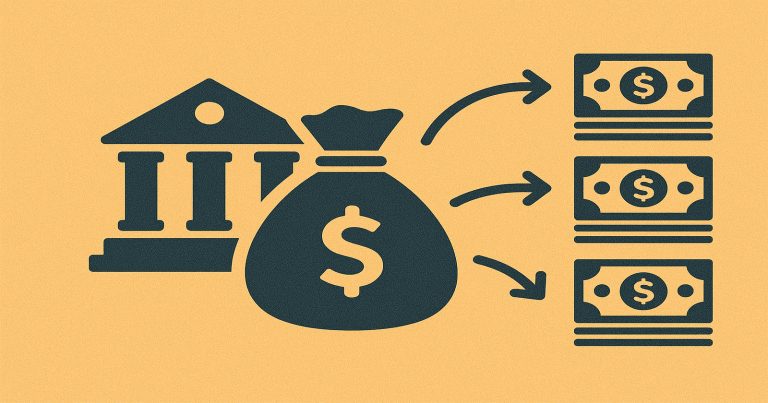The credit generation activity initiated by commercial banks constitutes the most significant contribution of those banks to a country’s economy. Thus, banks can generate money from deposits without printing new currency merely by allowing loans against customers’ deposits. The artificial growth of cash is necessary beyond liquidity: it serves essential purposes in investment, household consumption, and increases in business-related development and overall economic growth. However, these processes have limitations and depend on an economic-regulatory-institutional nexus variable. In detail, let’s look at the mechanism, significance, influencing factors, and constraints of credit generation by commercial banks.
Process of Credit Creation by Commercial Banks
Credit creation is a process whereby banks create new money by lending more than the deposits they have kept in reserve. This is because banks are not obligated to keep 100% of their deposits on hand; they need to keep only a fraction (known as the reserve ratio), which is then lent out. This system of the economy makes it possible for a new deposit to generate multiple rounds of credit, multiplying it exponentially in the total money supply.
Deposit Mobilisation
Initially, commercial banks start with deposit mobilisation acceptance from any person, business or institution. These deposits are liabilities for banks; however, they provide the latter as an input for lending funds. The whole credit cycle cannot be started without public deposits.
Reserve Requirement
Every bank is bound to keep a certain percentage of total deposits as reserves with the central bank (RBI) or keep its cash. The above conditions are the Cash Reserve Ratio (CRR) and the Statutory Liquidity Ratio (SLR). The rest is used for lending.
Loans
Instead of disbursing cash, it gives loans through crediting the borrower’s account with the amount sanctioned. This increases the deposit base because the amount borrowed stays in the banking system flow until it is drawn as cash.
Credit Multiplier Effect
When this loan is used to purchase or deposited in another bank, it forms a basis for further lending. This cycle continues, whereby the bank can generate outstanding credit many times on the original deposit as per the money multiplier formula.
Example of Credit Creation
For example, imagine depositing ₹10,000 with a 10% reserve ratio. The bank can now lend ₹9,000. If that ₹9,000 is re-deposited, then the next bank can lend another ₹8,100, and so on. This cycle eventually boosts the total money in circulation without any base currency increases.
Importance and Aspects of Credit Creation
Credit creation is a technical function and the backbone of economic development. It creates liquidity, raises entrepreneurship activities, increases investments, and hastens consumption. Without credit creation, modern economies would not have the flexibility and financing to grow efficiently.
Economic Growth
Credit enables entrepreneurs, businesses and governments to have capital available for investment in other aspects of their industries. In this way, startups procure innovations, industries further evolve, and infrastructure builds up. In direct effect, credit creation improves productivity and then GDP.
Increased Money Supply
When loans are issued, the quantity of money in the economy increases. The larger the amount of money moving around, the more demand it creates, which feeds supply and economic output. It makes the use of government expansionary fiscal policies effective.
Purchasing Power
With credit, much more financial capacity is available to consumers and businesses. Individual consumers can make larger purchases, such as homes, cars, or education, while firms can invest in production or expansion without having capital at hand right now.
Multiplier Effect
The multiplier effect creates a chain reaction. The first deposit supports many loan rounds, all adding more money into the system. This money multiplier effect makes the original deposit worth many times what it is.
Liquidity Management
In short cash-flow periods, credit grants businesses and individuals access to short-term obligations. It serves as a buffer against shocks financially and keeps the engine running smoothly within the economy.
Factors Adjusting the Credit Creation of Commercial Banks
Credit creation may be the most potent instrument ever, but may not be applicable in various situations, being affected at times by internal and other external factors; the following are the main internal and external factors: regulatory restrictions, macroeconomic conditions, lending behaviour, and public perception. Each of these aspects determines the level and efficiency of credit generation by banks.
Reserve Ratio
The higher the reserve ratio, which the central bank sets, the lower the funds available for lending will be. A low reserve ratio frees much of its funds, thus leading to more available credits. It is a regulation through which the money supply is controlled directly.
Public Confidence
People who are not confident in banks may not save deposits in such institutions. This will, in effect, lower the ability of those banks to create credit. Higher public confidence means higher deposits, thus credit expansion.
Lending Policies
A conservative bank will likely approve fewer loans since it wants to reduce the risk of defaults; hence, the bank will produce little credit. On the contrary, banks with liberal lending policies can generate more credit, despite higher risks.
Availability of Creditworthy Borrowers
Banks lend money only to those who fulfil all these conditions prescribed by creditworthiness or collateral. However, even a high liquidity level will not benefit credit generation if there is a lack of creditworthy borrowers.
Economic Stability
An excellent economy regularly makes people and businesses borrow more, whereas amid swelling or subsidence, the demand for loans drops significantly due to the disruption of the credit chain.
Intrigued Rates
Low-interest rates lure more advances, leading to more borrowing and credit creation. On the other hand, high-interest rates deter requests for advances, abating the credit cycle.
Impediments to Credit Creation by Commercial Banks
Even though credit creation may be valuable in numerous ways, it cannot be unhindered in its working mode. Organisation controls may administer such impediments, but so too genuine world financial matters, such as avoiding credit development beyond different measures or security with which this credit is expanded.
Legitimate Save Prerequisites
Strict savings and liquidity standards cap the amount of loans banks can make. This anticipates uncontrolled extension of cash supply, guaranteeing that banks continuously keep up a buffer for withdrawals.
Financial Retreat
Individuals and businesses tend to be bashful about borrowing in a lull period, and banks become risk-averse. As a result, the request for credit goes down, and the multiplier impact becomes powerless or stagnant.
Policies from the Central Bank
In this regard, the central bank (RBI in India) uses monetary tools like increased interest rates or open market operations to restrict credit growth, especially during inflationary periods.
Non-Performing Assets (NPAS)
Consequently, banks tend to be careful in their loan origination, and the loan origination levels are restricted. High NPAS reduce banks’ profitability and risk appetite, affecting credit continuation directly.
Liquidity Constitutes
Liquidity must always be enough for banks to meet customers’ withdrawal demands. If many depositors demand cash simultaneously, banks cannot afford to over-lend, limiting credit creation.
Anti-Inflationary Measures
Central banks reduce the flow of money whenever inflation rises by tightening their monetary policies. Increased interest rates then follow, and consequently, decreased bank lending.
Credit Creation vs Deposit Multiplier
The creation of deposits and credit enters into the core banking concepts when explaining the expansion of the money supply within an economy. Credit creation refers to the process by when a bank lends even more than the actual deposits it holds. In contrast, the deposit multiplier shows how much potential total money can be created from an initial deposit. Hence, these two processes show how banks increase liquidity and become engines for economic growth. While both concepts deal with money supply expansion, they serve different purposes. Here’s a detailed comparison:
| Basis | Credit Creation | Deposit Multiplier |
| Meaning | Expansion of credit via loans by banks | Theoretical model showing deposit potential |
| Trigger | Actual lending by commercial banks | Determined by the reserve ratio only |
| Formula | Credit = Initial Deposit × Money Multiplier | 1 ÷ Reserve Ratio |
| Nature | Practical and real-world | Theoretical and ideal |
| Dependency | Credit policies, reserves, and borrower demand | Only on the reserve requirement |
| Regulation Influence | Affected by CRR, SLR, and monetary policy | Purely mathematical |
| Example Use Case | Used in analysing real bank performance | Used to predict possible deposit expansion |
The Role of Central Banks in Credit Control
Central banks, such as the Reserve Bank of India (RBI), play a fundamental part in controlling the degree of credit that commercial banks extend. Whereas commercial banks can grow credit within the economy, the central bank guarantees that this development remains within secure and feasible limits. It does this by utilising financial approach instruments that impact the supply and availability of cash within the market.
Central Bank Apparatuses for Credit Control
The central bank utilises different quantitative apparatuses, such as the Cash Reserve Ratio (CRR), Statutory Liquidity Ratio (SLR), Repo Rate, and Turnaround Repo Rate. These apparatuses specifically affect how many open bank stores can utilise for loaning. For example, an increase in CRR decreases the number of stores accessible for lending, subsequently controlling excessive credit creation.
Financial Arrangement and Credit Creation
Through its monetary policy, the central bank chooses whether to advance or restrict the credit stream within the economy. It may receive a contractionary arrangement by raising interest rates in expansion. Amid a subsidence, an expansionary arrangement with lower rates and lower savings necessities energises credit creation to boost financial activity.
Credit Creation and Its Effect
Credit creation leads to an increment within the cash supply, which, if not coordinated by a corresponding increment in goods and services, can cause inflation. Understanding the interface between credit development and cost rise is vital for adjusting financial development with cost soundness.
How Credit Creation Impacts Inflation?
When banks make intemperate credit, shoppers and businesses have more cash to spend, driving up total demand. If this demand outpaces supply, it comes about in demand-pull expansion, where much money for a few merchandise items chases.
Inflationary vs. Non-Inflationary Credit
Credit utilised for profitable investment, such as in framework or manufacturing, is non-inflationary, mainly because it increases yield. Be that as it may, credit used for theoretical purposes like stock trading or genuine asset theory can lead to inflationary weights without including genuine financial value.
Credit Creation and Economic Development
The credit creation process has long been considered an economic development engine, providing the investable resources for investment, innovation, and expansion. Economists from various approaches have debated its power, influence, and sustainability.
Role in Capital Formation
Credit creation enables financial institutions to channel household savings into productive investment, thereby contributing to capital formation. This is important for a developing economy like India, which requires huge funds for its infrastructure, education, and technology sectors.
Credit Creation in Keynesian and Monetarist Perspectives
While Keynesians argue that credit supports aggregate demand and employment, thus imperative during economic downturns, Milton Friedman’s economists believe that indiscriminate credit growth leads to inflation and financial instability. Knowledge of both schools provides a balanced ground for formulating economic policies.
Credit Creation by Commercial Banks FAQS
Q1. What is credit creation?
Credit creation is the process by which commercial banks lend money over the actual cash they hold, thereby expanding the economy’s money supply.
Q2. What are the key requirements for credit creation?
Adequate public deposits, a low reserve ratio, economic stability, and creditworthy borrowers are essential for credit creation.
Q3. How do banks create money?
Banks lend a portion of their deposits, which then get redeposited in the system, allowing multiple rounds of lending through a multiplier effect.
Q4. Why is credit creation important?
It fuels economic growth by supporting the economy’s consumption, production, and liquidity.
Q5. Can credit creation cause inflation?
Yes, excessive credit creation can lead to too much money chasing too few goods, resulting in demand-pull inflation.


